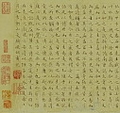
*******************************************************
"Tie", also known as model-calligraphy, has been in fashion in the Chinese calligraphy world for more than a millennium, and it is still very often used in practising calligraphy today.
Those who are interested in learning more about the heritage of the model-calligraphy school should not miss the latest exhibition at the Hong Kong Museum of Art, entitled "Ages of Model-calligraphy School: Selected Calligraphy Works from the Museum Collection", which is being held from today (August 19) until June 30 next year. Featuring more than 40 classical Chinese calligraphy works by master calligraphers from different eras, the exhibition enables visitors to learn what the model-calligraphy school is all about and explore the far-reaching influence of this art form on the development of Chinese calligraphy over the past millennium.
In the old days, "tie" referred to a note or a letter written on a small piece of silk. By the late Eastern Han (25-220), paper gradually replaced silk and bamboo slips as the main writing material following a revolution in writing implements. Since paper allows and better captures the swift movement of the writing brush, calligraphy evolved in time into an expressive means. By the Wei-Jin period (220-420), calligraphy had acquired the proportion of an art form thanks to the literati's predilection for writing their letters in running and cursive script. Collectively known as the Two Wangs, Wang Xizhi and his son Wang Xianzhi of the Eastern Jin became the doyens of mainstream calligraphy and their works laid the origins of "tie" that have since then taken on the wider sense of model-calligraphy.
Zhao Guangyi, the Emperor Taizong of the Northern Song (960-1127), gathered selected ancient calligraphic masterpieces into his imperial collection as the first imperial compendium of model-calligraphy, which is called "Model-Calligraphies from the Chunhua Archive". From then on, calligraphic carvings, whether by the court or by private individuals, have accordingly been named "tie", or model-calligraphy, and copying them is the undisputed first step in learning calligraphy.
At the exhibition, visitors can appreciate a number of masterpieces by leading calligraphers, such as "Poem on the Shuzi Spring Stone Carving" in running script by Zhao Mengfu, "Poems on Fallen Flowers" in small regular script by Wen Zhengming, "Eulogy on the Restoration of the Great Tang Dynasty" in running script by Dong Qichang and a poem inscribed on a painting in running script by Wang Wenzhi. Works by Ni Yuanlu, Wang Duo, Liu Yong, Yu Youren and Tai Jingnong are also featured. Apart from those calligraphy works selected from the Xubaizhai collection of the Hong Kong Museum of Art, the exhibition also features other selected collection items of the museum.
The Hong Kong Museum of Art is located at 10 Salisbury Road, Tsim Sha Tsui, Kowloon. It opens from 10am to 6pm from Sunday to Wednesday and Fridays, and from 10am to 8pm on Saturdays. It is closed on Thursdays (except public holidays). Admission is $10 and a half-price concession is available for full-time students, senior citizens and people with disabilities. Admission is free on Wednesdays.
For enquiries, call 2721 0116 or visit the Hong Kong Museum of Art's website www.lcsd.gov.hk/CE/Museum/Arts/english/exhibitions/exhibitions01_jul11_03.html.
Ends/Friday, August 19, 2011
Issued at HKT 19:10
NNNN






